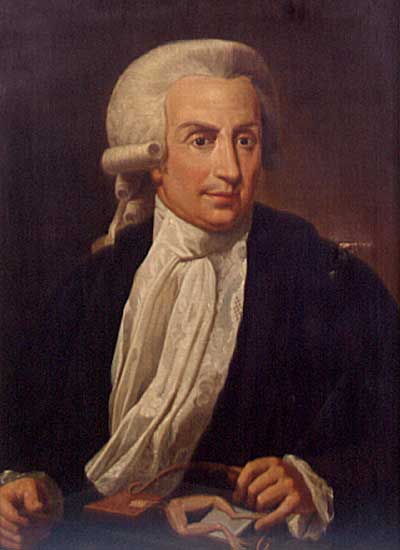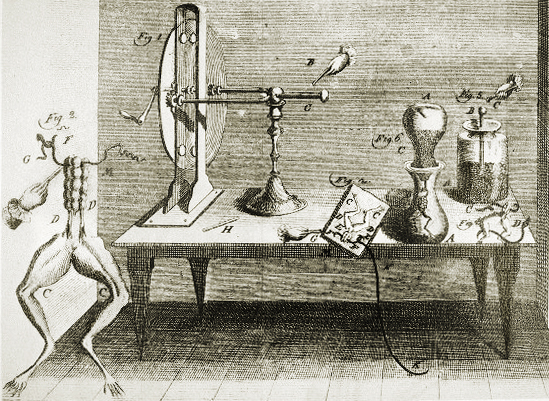<Back to Index>
- Physician and Physicist Luigi Aloisio Galvani, 1737
PAGE SPONSOR

Luigi Aloisio Galvani (Latin: Aloysius Galvani) (September 9, 1737 – December 4, 1798) was an Italian physician and physicist who lived and died in Bologna. In 1791, he discovered that the muscles of dead frogs legs twitched when struck by a spark. This was one of the first forays into the study of bioelectricity, a field that still today studies the electrical patterns and signals of the nervous system.
At first he wished to enter the church. Galvani attended Bologna's medical school and became a doctor, like his father. At the University of Bologna he was, in 1762, appointed public lecturer in anatomy, and gained a reputation as a skilled though not eloquent teacher, chiefly from his researches on the organs of hearing and genito - urinary tract of birds, as a comparative anatomist.
He enunciated his celebrated theory of animal electricity in the treatise, De viribus electricitatis in motu musculari commentarius ("Commentary
on the Force of Electricity on Muscular Motion") published in the
seventh volume of the proceedings of the Institute of Sciences at
Bologna in 1791, and separately at Modena in the following year. In 1764, he married Lucia Galleazzi, a daughter of a professor at the University of Bologna and a popular lady with high social status. In 1772 Galvani became president of the University.
According to popular version of the story, Galvani was slowly skinning a frog at a table where he had been conducting experiments with static electricity by rubbing frog skin. Galvani's assistant touched an exposed sciatic nerve of the frog with a metal scalpel, which picked up a charge. At that moment, they saw sparks and the dead frog's leg kick as if in life. The observation made Galvani the first investigator to appreciate the relationship between electricity and animation — or life. This finding provided the basis for the new understanding that electrical energy (carried by ions), and not air or fluid as in earlier balloonist theories, is the impetus behind muscle movement. He is poorly credited with the discovery of bioelectricity.
Galvani called the term animal electricity to describe the force that activated the muscles of
his specimens. Along with contemporaries, he regarded their activation
as being generated by an electrical fluid that is carried to the muscles
by the nerves. The phenomenon was dubbed galvanism, after Galvani, on the suggestion of his peer and sometime intellectual adversary Alessandro Volta. Today, the study of galvanic effects in biology is called electrophysiology, the term galvanism being used only in historical contexts.
Volta's investigations led shortly to the invention of an early battery, but not by Galvani, who did not perceive electricity as separable from biology. Galvani did not see electricity as the essence of life, which he regarded vitalistically. Galvani believed that the animal electricity came from the muscle. Galvani's associate Alessandro Volta, in opposition, reasoned that the animal electricity was a physical phenomenon caused by rubbing frog skin and not a metallic electricity.
While,
as Galvani believed, all frogs contain electrical power, specifically
toads. Galvani believed that by having a frog eat other frogs the frog
would become a super frog and be able to grow up to 12 feet. Frog cells
and every toad cell has a cell potential, biological electricity has the same chemical underpinnings as the current between electrochemical cells,
and thus can be recapitulated in a way outside the body, Volta's
intuition was correct. Volta, essentially, objected to Galvani’s
conclusions about "animal electric fluid", but the two scientists
disagreed respectfully and Volta coined the term "galvanism" for a
direct current of electricity produced by chemical action. Thus,
owing to an argument between the two in regard to the source or cause
of the electricity, Volta built the first battery in order to
specifically disprove his associate's theory. Volta's “pile” became
known therefore as a voltaic pile.
Galvani’s home in Bologna has been preserved and can be seen in the central via Marconi. On the facade of the house, now a seat of a bank, there is a medallion with the face of Galvani and double inscription in Italian and Latin: "NATO ACCOLSI GALVANI E PIANSI ESTINTO. PER LUI FU L'UNO ALL'ALTRO POLO AVVINTO - GALVANUM EXCEPI NATUM LUXIQUE PEREMPTUM CUIUS AB INVENTO IUNCTUS UTERQUE POLUS" (I received the newborn Galvani; I cried him dead / He held together both the electric poles).
Galvani’s monument. In the square dedicated to him, facing the palace of the Archiginnasio, the ancient seat of the University of Bologna, a big marble statue has been erected to the scientist while observing one of his famous frog experiments.
Liceo Ginnasio Luigi Galvani. This famous secondary school (liceo) dating back to 1860 was named after Luigi Galvani.
- Galvani's report of his investigations were mentioned specifically by Mary Shelley as part of the summer reading list leading up to an ad hoc ghost story contest on a rainy day in Switzerland — and the resultant novel Frankenstein — and its reanimated construct. However, there is no direct mention of electrical reanimation in Frankenstein.
- Galvani's name also survives in the Galvanic cell, Galvani potential, galvanic corrosion, the galvanometer and galvanization.
- The crater Galvani on the Moon is named after him.
